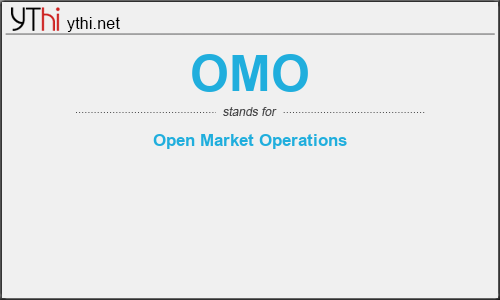What does OMO mean? What is the full form of OMO?
The full form of OMO is Open Market Operations
Open market operations (OMOs)–the purchase and sale of securities in the open market by a central bank–are a key tool used by the Federal Reserve in the implementation of monetary policy. The short-term objective for open market operations is specified by the Federal Open Market Committee (FOMC). OMOs are conducted by the Trading Desk at the Federal Reserve Bank of New York. The range of securities that the Federal Reserve is authorized to purchase and sell is relatively limited. The authority to conduct OMOs is found in section 14 of the Federal Reserve Act.
The Federal Reserve Bank of New York publishes a detailed explanation of OMOs each year in its Annual Report.
OMOs can be divided into two types: permanent and temporary. Permanent OMOs involve outright purchases or sales of securities for the System Open Market Account (SOMA), the Federal Reserve’s portfolio. Traditionally, permanent OMOs are used to accommodate the longer-term factors driving the expansion of the Federal Reserve’s balance sheet–primarily the trend growth of currency in circulation. During and after the financial crisis, permanent OMOs were used to adjust the Federal Reserve’s holdings of securities in order to put downward pressure on longer-term interest rates and to make financial conditions more accommodative. Currently, permanent OMOs are used to implement the FOMC’s policies of reinvesting principal payments from its holdings of agency debt and mortgage-backed securities (MBS) in agency MBS and of rolling over maturing Treasury securities at auction.
Temporary OMOs are typically used to address reserve needs that are deemed to be transitory in nature. These operations are either repurchase agreements (repos) or reverse repurchase agreements (reverse repos or RRPs). Under a repo, the Trading Desk buys a security under an agreement to resell that security in the future. A repo is the economic equivalent to a collateralized loan by the Federal Reserve, in which the difference between the purchase and sale prices reflects interest. Under a reverse repo, the Trading Desk sells a security under an agreement to repurchase that security in the future. A reverse repo is the economic equivalent of collateralized borrowing by the Federal Reserve. Overnight reverse repos are currently used as a tool to help keep the federal funds rate in the target range established by the FOMC.
OMO
means
Open Market Operations![]()
Translate Open Market Operations to other language.


Leave a Reply
You must be logged in to post a comment.